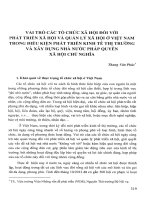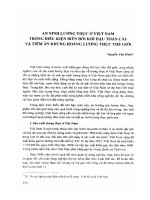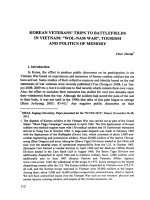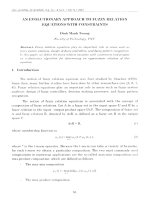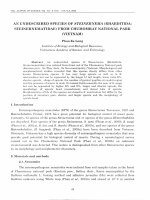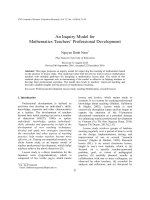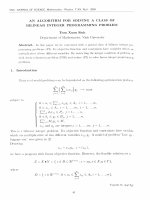DSpace at VNU: An algorithmic approach to constructing mixed-level orthogonal and near-orthogonal arrays
Bạn đang xem bản rút gọn của tài liệu. Xem và tải ngay bản đầy đủ của tài liệu tại đây (347.65 KB, 8 trang )
Computational Statistics and Data Analysis 52 (2008) 5269–5276
Contents lists available at ScienceDirect
Computational Statistics and Data Analysis
journal homepage: www.elsevier.com/locate/csda
An algorithmic approach to constructing mixed-level orthogonal and
near-orthogonal arrays
Nam-Ky Nguyen a , Min-Qian Liu b,c,∗
a
Centre for High-Performance Computing, Hanoi University of Science, 334 Nguyen Trai, Thanh Xuan, Hanoi, Viet Nam
b
Department of Statistics, School of Mathematical Sciences, Nankai University, Tianjin 300071, China
c
LPMC, Nankai University, Tianjin 300071, China
article
info
Article history:
Received 31 July 2007
Received in revised form 18 April 2008
Accepted 7 May 2008
Available online 14 May 2008
a b s t r a c t
Due to run size constraints, near-orthogonal arrays (near-OAs) and supersaturated designs,
a special case of near-OA, are considered good alternatives to OAs. This paper shows (i) a
combinatorial relationship between a mixed-level array and a non-resolvable incomplete
block design (IBD) with varying replications (and its dual, a resolvable IBD with varying
block sizes); (ii) the relationship between the criterion E (d2 ) proposed by Lu and Sun [Lu,
X., Sun, Y., 2001. Supersaturated designs with more than two levels. Chinese Ann. Math.
B 22, 183–194] or E (fNOD ) proposed by Fang et al. [Fang, K.T., Lin, D.K.J., Liu, M.Q., 2003b.
Optimal mixed-level supersaturated design. Metrika 58, 279–291] used in the (near-) OA
construction and the (M , S )-optimality criterion used in the IBD construction; (iii) the
derivation of a tighter bound for E (d2 ); (iv) how to modify the IBD algorithm of Nguyen
[Nguyen, N.-K., 1994. Construction of optimal incomplete block designs by computer.
Technometrics 36, 300–307] to obtain efficient (near-) OA algorithms. Some new (near-)
OAs are presented and some near-OAs are compared with arrays constructed by other
authors. Examples showing the use of the constructed arrays are given.
© 2008 Elsevier B.V. All rights reserved.
1. Introduction
We will begin by providing two examples to illustrate the use of near-OAs.
Example 1. A wood scientist was asked to develop plywood of certain strength which was needed for the floor of cargo
containers. As the strength could not be determined from first principles and because test data would be necessary to
convince the regulatory authorities once a product was developed, she had to investigate a number of combinations of
four timber species, four adhesive types, four different initial moisture contents, three hot press pressures, two cold press
times, two levels of filler added to the adhesive resin, two levels of insecticide added to the adhesive resin and two types of
fungicides. An OA for three 4-level factors, one 3-level factor and four 2-level factors requires a run size that is divisible by
4 × 4, 4 × 3, 4 × 2, 3 × 2, and 2 × 2, so the L48 (43 31 24 ) in 48 runs (cf. />is the smallest possible OA. However, because of the time and cost constraints, at most half of the number of suggested runs
are allowed. What should be the suitable design for this experiment?
Example 2. Nguyen and Cheng (2008) described a passenger-impact crash test experiment on a planned new four-wheeldrive range whose objective is to find a subset of 54 safety features. They proposed a 2-level supersaturated design with
∗ Corresponding author at: Department of Statistics, School of Mathematical Sciences, Nankai University, Tianjin 300071, China. Tel.: +86 22 23504709;
fax: +86 22 23506423.
E-mail addresses: (N.-K. Nguyen), (M.-Q. Liu).
0167-9473/$ – see front matter © 2008 Elsevier B.V. All rights reserved.
doi:10.1016/j.csda.2008.05.004
5270
N.-K. Nguyen, M.-Q. Liu / Computational Statistics and Data Analysis 52 (2008) 5269–5276
Table 1
L6 (31 23 )
0
0
1
1
2
2
0
1
0
1
0
1
0
1
1
0
1
0
1
0
1
0
0
1
(n, m) = (27, 54) which only used 27 car prototypes. Now assume that the R & D Department wants to incorporate an
additional 3-level factor into this experiment, i.e. car speed and is keen to know how this can be done.
Before discussing the near-OA solutions to the above problems, we discuss OA. A strength 2 OA of size n with k sj -level
columns (j = 1, . . . , k), denoted by Ln (s1 , . . . , sk ) is an n × k matrix in which all possible combinations of levels in any two
columns appear the same number of times Rao (1947). There is an OA library of over 200 OAs maintained by Prof. N. J. A.
Sloane ( This library has been recently updated by Dr. W. F. Kuhfeld of SAS at his
OA site ( This site contains all OAs listed in the Appendix of Kuhfeld
and Tobias (2005) as well as new ones contributed by other authors.
A near-OA, denoted by Ln (s1 · · · sk ), is an array in which the orthogonality requirement is nearly satisfied. The concept of
near-OA (Taguchi, 1959; Wang and Wu, 1992; Nguyen, 1996b; Ma et al., 2000; Xu, 2002; Lu et al., 2006) provides a genuine
answer to situations when OAs are not available. An array is called a saturated design when
(si − 1) = n − 1 (e.g. a
Plackett–Burman design) and is called a supersaturated design when (si − 1) > n − 1. Supersaturated designs were first
examined by Booth and Cox (1962) systematically, and were not studied further until the appearance of the work by Lin
(1993) and Wu (1993). Since then, there has been a large number of papers on this subject, see some most recent papers,
e.g. Nguyen and Cheng (2008), Chen and Liu (2008a,b), Liu and Lin (in press), and the references therein.
Note that, although almost all the near-OAs and supersaturated designs studied in the existing papers, except perhaps
those in Nguyen and Cheng (2008) and Chen and Liu (2008b), are U-type designs, i.e. arrays in which all levels appear equally
often for any column Fang et al. (2006), the results we developed here, i.e. the relationships, tighter bound and algorithms,
are not restricted to U-type designs, see for example the solution for Example 2 and the detailed discussions in the following
sections.
This paper is organized as follows. Section 2 shows a combinatorial relationship between a mixed-level array (OA
and near-OA) and an IBD. Section 3 shows the relationship between the popular criterion E (d2 ) (or E (fNOD )) used in the
construction of the mentioned type of designs and the (M , S )-optimality criterion used in IBD construction. In this section,
we will show the derivation of a tighter bound for E (d2 ). Section 4 describes two new (near-) OA algorithms which are
modifications of the IBD algorithm of Nguyen (1994). Section 5 compares some near-OAs constructed by the new algorithm
and by other authors in terms of the D-efficiency of the designs and other goodness criteria.
2. Relationship between an array and an IBD
There is a relationship between certain combinatorial structures with IBDs. Box and Behnken (1960) used balanced IBDs
and partially balanced IBD to construct 3-level response surface designs. Nguyen and Borkowski (2008) used regular graph
designs (RGDs) to construct this type of designs. Nguyen (1996a) and Liu and Zhang (2000) used cyclic balanced IBDs to
construct 2-level supersaturated designs. Lu et al. (2003), Fang et al. (2002, 2003a, 2004a,b,c) and Liu and Fang (2005) used
resolvable balanced IBDs, resolvable group divisible designs, packing designs and large sets to construct multi- and mixedlevel supersaturated designs. Nguyen and Cheng (2008) used RGDs to construct saturated and supersaturated designs.
Consider the mixed-level near-OA L6 (31 23 ) given in Table 1. If we use the dummy coding to code this near-OA, we will
get the following X matrix:
1
1
0
0
0
0
0
0
1
1
0
0
0
0
0
0
1
1
1
0
1
0
1
0
0
1
0
1
0
1
1
0
0
1
0
1
0
1
1
0
1
0
0
1
0
1
1
0
1
0
1
.
0
0
1
(1)
It can be seen that Eq. (1) is the N matrix (transpose of the incidence matrix) of the non-resolvable IBD with varying
replications of size (v, b, k) = (9, 6, 4) in Table 2.
A non-resolvable IBD of size (v, b, k) has v varieties, each replicated ri times (i = 0, . . . , v − 1), set out in b blocks of size
k (
of the IBD in Table 2 has varieties 0–2 which corresponds to the three levels of column 1 of the array in Table 1. Similarly,
the 2nd position of each block of this IBD has varieties 3–4 which correspond to the two levels of column 2 of this array,
N.-K. Nguyen, M.-Q. Liu / Computational Statistics and Data Analysis 52 (2008) 5269–5276
5271
Table 2
IBD of size (v, b, k) = (9, 6, 4)
0
0
1
1
2
2
3
4
3
4
3
4
5
6
6
5
6
5
8
7
8
7
7
8
03
23
43
14
34
54
05
35
55
16
26
46
17
37
47
08
28
58
Blocks are rows.
Table 3
RIBD of size (v, b, r ) = (6, 9, 4)
00
10
21
31
42
52
Subscripts denote block number.
etc. Associated with each IBD is the incidence matrix Nv×b whose (ij)th element equals 1 if variety i occurs in block j and 0
otherwise.
It can be seen that Eq. (1) is also the incidence matrix N of the resolvable IBD (RIBD) with varying block sizes of size
(v, b, r ) = (6, 9, 4) in Table 3.
An RIBD of size (v, b, r ) has v varieties, each replicated r times, set out in b blocks, each of size ki (i = 0, . . . , b − 1),
i.e.
ki = v r. These blocks can be divided into subsets, each of which represents a complete replication of the varieties.
Each column of the RIBD in Table 3 represents a replicate. The first replicate, for example, has three blocks (0, 1), (2, 3) and
(4, 5). This IBD is, in fact the dual of the primal IBD in Table 2. The dual of an IBD is a new IBD obtained by swapping the
varieties and block symbols in the original design (cf. pp. 39–41 of John and Williams (1995)). So we conclude that
Theorem 1. There exists a one-to-one correspondence between a mixed-level array of size n with k sj -level columns (j =
()
1, . . . , k), Ln (s1 · · · sk ), and a non-resolvable IBD of size (v, b, k) = (
(n, sj , k)).
sj , n, k) (and its dual, an RIBD of size (v, b, r ) =
Remark. 1. Associated with each IBD is the concurrence matrix NN whose (ii)th element is ri and (ij)th element is the
number of blocks in which both varieties i and j appear. The concurrence matrix of the IBD in Table 2 and the one of the RIBD
in Table 3 (or N N) are:
2
0
0
1
1
1
1
1
1
0
2
0
1
1
1
1
1
1
0
0
2
1
1
1
1
1
1
1
1
1
3
0
1
2
1
2
1
1
1
0
3
2
1
2
1
1
1
1
1
2
3
0
1
2
1
1
1
2
1
0
3
2
1
1
1
1
1
2
1
2
3
0
1
1
1
2
1
2
1
0
3
4
and
1
2
1
1
2
1
4
1
2
2
1
2
1
4
1
2
1
1
2
1
4
1
2
1
2
2
1
4
1
2
1
1
2
1
4
(2)
respectively.
2. As a result of the combinational relationship shown in Theorem 1, we can construct the array indirectly by constructing
either IBD which involves the minimization of the sum of squares of the elements of either matrix in Eq. (2). This is called
the (M , S )-optimality criterion in the IBD literature (cf. pp. 34–35 of John and Williams (1995)).
3. Relationship between the E (d 2 )- and (M , S )-optimality criteria
Given a near-OA Ln (s1 , . . . , sk ), following Lu and Sun (2001) and Fang et al. (2003b), we define ‘‘a measure of departure
from orthogonality’’ for two columns i and j of this array and the overall measure of departure from orthogonality of this
array as:
si − 1 sj − 1
d2ij =
u=0 w=0
nijuw −
n
si sj
2
,
and
5272
N.-K. Nguyen, M.-Q. Liu / Computational Statistics and Data Analysis 52 (2008) 5269–5276
k−1
k
E (d2 ) =
k
d2ij
2
i=1 j=i+1
,
ij
respectively. Here nuw is the observed frequencies of rows whose column i takes symbol u and column j takes symbol w .
n/(si sj ) is the expected frequency for each level combination.
Note that the sum of the elements of NN and N N are nk2 and
ri2 respectively which are constants. As such, the (M , S )optimality criterion only involves the minimization of the sum of squares of the elements in either NN or N N, i.e. minimizing
trace(NN )2 or trace(N N )2 (note that trace(NN )2 = trace(N N )2 ). It can then be shown that:
Theorem 2.
k
2
E (d2 ) =
i
j>i
u
w
(nijuw )2 − C
= trace(NN )2 −
where C =
j>i
i
ri2
2 − C,
(3)
n2 /(si sj ) is a constant.
Eq. (3) establishes the relationship between E (d2 ) and the (M , S )-optimality criterion. It is also the generalization of the
results of Fang et al. (2003b, 2004b) which requires the run size n to be divisible by si . We can use this relationship to find a
better lower bound for E (d2 ).
First, let us use the primal IBD. The upper-diagonal of NN contains
k
2
sub-matrices Λij (i = 1, . . . , k − 1, j =
i + 1, . . . , k). The sum of the elements in Λij is n, and the sum of squares of the elements in this matrix is minimal if it
equals Sij = l1 λ2 + l2 (λ + 1)2 (i.e. each Λij has l1 values λ and l2 values λ + 1), where λ = n/(si sj ) , l2 = n − λsi sj and
l1 = si sj − l2 , l is the integer part of l. Thus, the first lower bound for E (d2 ) is:
Bp =
k
Sij − C
i
2
j>i
.
(4)
This derivation of Bp is parallel to the one in Ma et al. (2000) and Lu et al. (2006) (see also p. 81 of John and Williams (1995)).
Obviously, when the array is an OA, Eq. (4) becomes 0.
Now, let us use the dual IBD. The sum of the upper-diagonal elements of N N can be S = ( ri2 − nk)/2. The sum of
squares of the elements above the diagonal of N N is minimal if it equals Sd = m1 κ 2 + m2 (κ + 1)2 (i.e. these elements
n
n
n
consist of m1 values κ and m2 values κ + 1) where κ = S / 2 , m2 = S − κ 2 and m1 = 2 − m2 . In this case, the sum
2
2
of squares of the elements above the diagonal elements of NN is Sp = (2Sd + nk −
ri )/2 where 2Sd + nk2 is the sum of
2
squares of the elements of N N (or NN ). Thus the second lower bound for E (d ) is:
Bd = (Sp − C )
k
2
.
(5)
The derivation of Bd simplifies and generalizes the ones in Fang et al. (2003b, 2004b) which restrict the run size n to be
divisible by si . Thus we get the lower bound for E (d2 ):
Theorem 3.
E (d2 ) ≥ max(Bp , Bd ).
Remark. 1. The J2 of Xu (2002) is the sum of squares of the elements above the diagonal of the N N matrix associated with
the array. This J2 reaches Xu’s lower bound for J2 when J2 = (2C − nk2 +
ri2 )/2. Xu’s lower bound for J2 is useful to check
whether the constructed array is an OA but cannot be used to check whether the constructed near-OA is E (d2 )-optimal.
2. Fang et al. (2003b) showed that E (d2 ) = E (s2 )/4 where E (s2 ) is a criterion proposed by Booth and Cox (1962) and used
for supersaturated designs with factors coded at two levels ±1.
3. The E (d2 )’s of the array in Table 1 and several near-OAs in Section 5 reach both the lower bounds in Eq. (4) and
Eq. (5). However, there are situations in which the E (d2 ) value of a particular near-OA reaches Bp but not Bd and vice versa.
The E (d2 ) of the two L18 (21 38 )’s in Table 7 of Xu (2002) reaches Bd (=0.5) but not Bp (=0). The E (d2 ) of the near-OA L24 (310 )
in Table A7 of Lu et al. (2006) reaches Bp (=2) but not Bd (=0). Similarly, the E (d2 ) of the near-OA L10 (51 25 ) in Table 4 reaches
Bp (=0.6666) but not Bd (=0).
4. The E (d2 ) criterion used in the (near-) OA construction, like the (M , S )-optimality criterion used in the IBD construction,
is an approximate criterion in design construction. Table 3 of Lu et al. (2006) lists six L12 (31 29 )’s. It can be seen that the
arrays with the largest value of D (D-efficiency) in this table (i.e. the ones reported in Nguyen (1996b) and Xu (2002)) are
not necessarily the ones with the smallest E (d2 ).
N.-K. Nguyen, M.-Q. Liu / Computational Statistics and Data Analysis 52 (2008) 5269–5276
5273
Table 4
L10 (51 25 )
0
0
1
1
2
2
3
3
4
4
0
1
0
1
0
1
0
1
0
1
0
1
1
0
1
0
1
0
0
1
0
1
0
1
1
0
1
0
1
0
0
1
1
0
0
1
1
0
1
0
1
0
0
1
0
1
1
0
0
1
4. Algorithms for constructing (near-) OAs
We have two algorithms for array construction. The primal algorithm makes use of the relationship between an array and
a non-resolvable IBD. The dual algorithm makes use of the relationship between an array and an RIBD. Both algorithms use
the E (d2 ) criterion. This criterion is akin to the (M , S )-optimality criterion which involved the minimization of the sum of
squares of the elements above the diagonal elements of NN (or N N). Before discussing our algorithms, we give the details
of the update of our objective function f
=
k
2
E (d2 ) and NN matrix that are crucial in speeding up our algorithm.
Let i be a variety in position j of block I and t be a variety in another position of this block. Let m be a variety in position j
of block M and t be a variety in another position of this block. The pairwise swapping of i and m will increase all λtm ’s and
λt i ’s by 1 and decrease all λti ’s and λt m ’s by 1. This means that f will be increased by an amount:
(λtm − λti + 1) +
∆f = 2
(λt i − λt m + 1) .
(6)
The steps of the primal algorithm making use of the update formula in Eq. (6) are:
()
Step 1. Construct a starting array Ln (s1 , . . . , sk ) by allocating sj symbols 0, . . . , sj − 1 to column j such that the numbers
of these symbols differ by at most 1. Randomize the positions of each symbol. Convert this array to an IBD of size
(v, b, k) = ( sj , n, k). Construct the NN matrix of this IBD. Deduct each element of the sub-matrix Λij (i, j =
1, . . . , k, j > i) by an amount n/(si sj ) and calculate f , the sum of squares of the elements of these sub-matrices.
Step 2. Repeat searching a pair of varieties i and m in position j (j = 1, . . . , k) in two different blocks such that the swap
of these two varieties results in the biggest reduction of f . If the search is successful, update f , NN and the IBD.
If f cannot be reduced further, go to the next position. This process is repeated until f reaches its lower bound
i.e. max(Bp , Bd )
k
2
or cannot be reduced further.
()
Step 3. Convert the IBD in Step 2 to the array Ln (s1 , . . . , sk ) and calculate some goodness statistics for this array such
as the D, Vmax = max(Vij ), where Vij is Cramer’s V coefficient of association between two columns i and j
( and the fmax , the frequency of Vij = Vmax .
Step 4. The basic algorithm (i.e. Steps 1–3) is repeated a number of times to avoid the local optima. Each time is called a try.
Among a large number of tries, the best one with respect to a chosen goodness criterion is selected.
Our algorithm uses D in conjunction with Vmax and fmax as the goodness criterion. f is used instead of D when the design
is supersaturated.
Remark. 1. With the dual algorithm, the dual of the IBD used in the primal algorithm and N N will be used instead. Varieties
in different blocks of the same replicate will be swapped. There is a resemblance with this algorithm and the one of Xu
(2002) as both work with matrix N N. Both primal and dual algorithms work better than algorithms which maximizes the
D-efficiency such as the Fedorov exchange algorithm (cf. Nguyen and Miller (1992)) in terms of speed and the number of
pairs of orthogonal columns.
2. New arrays can be constructed by adding new columns to an existing array. The primal algorithm requires less
calculations than the dual one in this type of array construction as it only works with a sub-matrix of NN which involves
new columns.
3. There are situations in which experimenters are interested in arrays with minimal max(d2 ) = max{d2ij } (and the
minimum number of dij = max(d2 )). This type of array can be indirectly constructed by the primal algorithm by minimizing
ij
ij
ij
ij
ij
max(δuw ) where δuw = |nuw − n/(si sj )| and the frequency of δuw = max(δuw ). The stopping rule for this minimax algorithm
ij
is that each δuw < 1.
4. There are also situations in which experimenters consider certain factors (columns) as more important than the
remaining ones. In other words, they prefer the former to be orthogonal (or close to orthogonal) among themselves and
to the latter. Again, this type of array can be easily obtained via the primal algorithm by defining a second objective function
calculated from elements of a sub-matrix of NN which involves the mentioned factors.
5274
N.-K. Nguyen, M.-Q. Liu / Computational Statistics and Data Analysis 52 (2008) 5269–5276
Table 5
Comparison of near-OAs in terms of D and Np
Wang and Wua
#
Array
1
2
3
4
5
6
7
8
9
10
11
12
13
14
15
16
17
18
19
20
21
22
23
24
L6 (3 2 )
L10 (51 25 )
L12 (41 34 )
L12 (23 34 )
L12 (61 25 )
L12 (61 26 )
L12 (31 29 )
L12 (21 35 )
L12 (32 27 )
L12 (33 25 )
L15 (51 35 )
L18 (21 38 )
L18 (23 37 )
L18 (91 28 )
L20 (51 215 )
L24 (81 38 )
L24 (31 221 )
L24 (61 215 )
L24 (61 218 )
L24 (21 311 )
L24 (31 47 )
L36 (313 29 )
L50 (511 25 )
L54 (325 23 )
1 3
Ma, Fang and Liskia
901 ( 3)
883 (10)
946 ( 6)
946 ( 6)
911 ( 6)
901 ( 3)
967 (10)
946 ( 6)
946 ( 6)
911 ( 3)
909 ( 4)
905 ( 5)
867 ( 9)
877 (10)
882 (10)
970 ( 3)
985 (28)
838 (30)
897 (28)
853 (21)
870 (18)
970 ( 7)
985 (28)
623 (14)
845 (31)
953 (14)
934 (12)
761 (18)
871 (55)
594 (21)
a
103 D (the larger the better) and Np (the smaller the better).
103 Vmax (the smaller the better) and fmax of authors’ array.
E (d2 )-optimal arrays.
Authorsa
Vmax b
c
901 ( 3)
967 (10)
946 ( 6)
946 ( 6)
959 ( 4)
947 ( 6)
933 ( 6)
877 (10)
909 ( 6)
877 ( 6)
882 (10)
967 ( 3)
970 ( 3)
985 (28)
925 (19)
897 (28)
968 (23)
994 ( 1)
974 ( 6)
895 (56)
858 (21)
899 ( 6)
877 ( 6)
882 (10)
b
c
Xua
901 ( 3)
967 (10)c
946 ( 6)c
946 ( 6)c
959 ( 4)
947 ( 6)
933 ( 8)
877 (10)
888 ( 8)
925 ( 9)
882 (10)c
967 ( 3)c
970 ( 3)c
985 (28)c
956 (18)
897 (28)c
968 ( 8)
994 ( 1)
974 ( 6)
895 (55)
874 (21)
978 ( 8)
994 (10)
990 ( 3)c
333 ( 3)
200 (10)
250 ( 6)
250 ( 6)
333 ( 4)
333 ( 6)
333 ( 8)
250 (10)
333 ( 7)
333 ( 6)
200 (10)
289 ( 3)
333 ( 3)
111 (28)
200 (18)
125 (28)
333 ( 8)
333 ( 1)
333 ( 6)
177 (11)
236 ( 2)
333 ( 8)
200 (10)
333 ( 3)
Table 6
Two L12 (31 29 )’s
1
2
3
4
5
6
7
8
9
10
6
7
8
9
10
0
0
0
0
1
1
1
1
2
2
2
2
0
1
0
1
0
1
0
1
0
1
0
1
1
0
1
0
0
1
1
0
0
1
0
1
0
0
1
1
0
0
1
1
1
0
0
1
1
1
0
0
0
0
1
1
0
0
1
1
1
1
1
0
0
0
0
1
1
1
0
0
1
0
0
1
0
1
0
1
1
0
1
0
0
0
1
1
0
0
1
1
0
1
1
0
0
1
1
0
0
1
1
0
1
0
1
0
0
0
1
0
1
1
0
1
0
0
1
1
0
0
1
1
0
0
1
1
0
1
1
0
0
0
1
1
1
1
0
0
0
0
1
1
0
1
1
0
0
1
0
1
1
0
1
0
1
0
0
1
0
1
0
1
1
0
1
0
1
0
1
0
1
0
0
1
0
1
0
1
Columns 1–5 form an L12 (31 24 ). This OA and columns 6–10 form Xu’s array. This OA and columns 6 – 10 form ours.
5. Discussion
Table 5 gives a listing of 24 near-OAs constructed by Wang and Wu (1992), Ma et al. (2000), Xu (2002) and the authors in
terms of the D and Np (the number of non-orthogonal pairs). Our arrays also give details of the Vmax and fmax . Our arrays are
restricted to those with Vmax ≤ 0.333. As a result, two of our arrays are not as good as arrays of other authors with respect
to other measures of goodness. For the L12 (31 29 ) (#7), both Xu’s array and ours have D = 0.933 (Table 6). The Np of the
Xu’s array is 6 and of ours is 8. However, the Vmax of the former is 0.408 and of the latter is 0.333. For this L12 (31 29 ), the first
3-level column of the array of Lu et al. (2006) and ours is orthogonal to the remaining columns. The Np of Lu, Li and Xie’s
array is 7 and of ours is 8. However, the Vmax of the former is 0.667 and of the latter is 0.333.
Similarly, for L12 (32 27 ) (#9), the D and Np of Xu’s array are 0.909 and 6 and of ours are 0.888 and 8. However, the Vmax of
the former is 0.408 and of the latter is 0.333. In terms of D, we were able to improve three arrays of Xu in Table 5 (i.e. #10,
#15, and #21). In terms of Np , we were able to improve three arrays of Xu in this table (i.e. #15, #17, and #20). 10 out of 24
k
k
arrays in this table are E (d2 )-optimal. Arrays in this table are of the form Ln (s11 s22 ). The first k1 columns of our arrays are
always orthogonal to the remaining k2 columns. It is clear that arrays #7 and #9 of Xu do not have this feature and it is not
clear that the other arrays of Xu have this feature.
N.-K. Nguyen, M.-Q. Liu / Computational Statistics and Data Analysis 52 (2008) 5269–5276
5275
Table 7
Two L24 (61 215 )’s
1
2
3
4
5
6
7
8
9
10
11
12
13
14
15
16
16
0
0
0
0
1
1
1
1
2
2
2
2
3
3
3
3
4
4
4
4
5
5
5
5
0
0
1
1
0
0
1
1
0
0
1
1
0
0
1
1
0
0
1
1
0
0
1
1
0
1
0
1
1
1
0
0
0
0
1
1
0
0
1
1
1
1
0
0
0
1
0
1
0
0
1
1
0
1
0
1
0
1
0
1
1
1
0
0
0
1
0
1
0
1
0
1
0
0
1
1
1
1
0
0
1
0
1
0
0
1
0
1
0
1
0
1
1
0
1
0
0
0
1
1
1
0
1
0
1
1
0
0
0
1
0
1
1
0
1
0
0
1
0
1
0
1
0
1
1
0
1
0
1
1
0
0
1
0
1
0
0
1
0
1
0
0
1
1
0
1
0
1
0
0
1
1
0
1
0
1
0
1
0
1
1
1
0
0
1
0
1
0
0
1
0
1
0
1
0
1
1
0
1
0
1
1
0
0
1
0
1
0
0
0
1
1
0
0
1
1
0
0
1
1
1
0
1
0
1
0
1
0
1
1
0
0
1
1
0
0
0
1
0
1
1
0
1
0
0
0
1
1
1
1
0
0
0
0
1
1
1
1
0
0
0
1
1
0
0
1
1
0
1
0
0
1
0
1
1
0
1
0
0
1
1
0
0
1
0
0
1
1
1
1
0
0
0
1
0
1
1
0
1
0
1
0
1
0
1
0
1
0
0
1
0
1
0
1
0
1
1
1
0
0
0
0
1
1
0
0
1
1
1
1
0
0
0
1
1
0
1
0
0
1
0
1
1
0
0
1
1
0
0
1
1
0
1
0
0
1
0
1
1
0
0
1
1
0
1
0
0
1
0
1
1
0
0
1
1
0
0
1
1
0
1
0
0
1
1
0
0
1
0
0
1
1
0
1
1
0
1
0
0
1
1
0
0
1
Columns 1–15 form an L24 (61 214 ). This OA and column 16 form the 1st near-OA. This OA and column 16 form the 2nd near-OA.
Table 8
L24 (43 31 24 )
0
0
0
0
0
0
1
1
1
1
1
1
2
2
2
2
2
2
3
3
3
3
3
3
0
0
1
2
2
3
0
0
1
1
2
3
0
1
1
2
3
3
0
1
2
2
3
3
0
1
3
0
2
1
1
3
2
3
0
2
2
0
2
1
3
3
0
1
1
3
0
2
1
0
2
0
2
1
2
0
0
1
2
1
2
0
1
1
0
2
1
2
0
1
2
0
1
0
0
1
1
0
1
0
1
1
0
0
0
0
0
1
1
1
1
1
0
0
0
1
0
0
0
1
1
1
0
1
0
1
0
1
1
1
0
0
0
1
1
1
1
0
0
0
0
1
1
1
0
0
0
1
0
0
1
1
0
0
1
1
0
1
1
1
0
0
0
1
0
0
1
1
0
1
1
0
0
1
1
0
1
0
1
0
1
0
1
0
1
0
0
1
We have two solutions for array L24 (61 215 ) (#18). The 2nd solution obtained by the minimax criterion has D = 0.988
instead of 0.994 and Np = 8 instead of 1 (Table 7). However, its Vmax is 0.167 instead of 0.333. To many experimenters, this
solution is a preferred one despite its low D.
The solution for Example 1 is the following E (d2 )-optimal L24 (43 31 24 ) (Table 8). It has D = 0.978 and Vmax = 0.193
with fmax = 3. The last five columns of this array form an OA and the first three columns of this array are orthogonal to the
remaining columns. The solution for Example 2 is an E (d2 )-optimal L27 (31 254 ) with Vmax = 0.421 and fmax = 3. All near-OAs
in Table 5 and the solutions for the two examples can be found at />The work of Lu et al. (2006) becomes relevant in light of this research. Table 1 of Lu et al. (2006) provides details of 13
near-OAs consisting of 2- and 3-level factors. Out of these 13 arrays, we were able to improve the D’s of eight of them. These
arrays are #1, #2, #4, #5, #8, #10, #11, and #13 in this table. The D’s of Lu et al. (2006) for these arrays are 0.905, 0.948,
0.882, 0.881, 0.833, 0.837, 0.772 and 0.854 compared with 0.933, 0.954, 0.888, 0.950, 0.877, 0.891, 0.967 and 0.909 for the
5276
N.-K. Nguyen, M.-Q. Liu / Computational Statistics and Data Analysis 52 (2008) 5269–5276
algorithm in Section 4. There is evidence that this table was made with insufficient tries (e.g. their algorithm stops as soon
as E (d2 ) is reached). Despite this, we were not able to obtain the E (d2 )-optimal L21 (310 ) reported in this table after a very
large number of tries. Basically, this suggests that no algorithm is good for all situations.
As mentioned, one of the main features of our algorithm is its ability to add additional columns to existing arrays. Several
new OAs and near-OAs can be constructed this way. Our new L36 (213 32 61 ), L60 (215 61 101 ), L84 (214 61 141 ) and L100 (104 24 )
are listed at The L100 (104 24 ), for example, was constructed by adding
four additional 2-level columns to the well-known L100 (104 ). Our new E (d2 )-optimal L84 (28 61 141 32 ) and L100 (104 24 32 ) and
other smaller near-OAs are listed at />Both algorithms reported in Section 4 are very fast. For small arrays such as the L12 (33 25 ), the primal algorithm takes
about two seconds on our Core Duo 2 GHz laptop to obtain 1000 tries. Out of these 1000 tries, 143 have D = 0.925. For
larger arrays such as the L24 (61 46 ), this algorithm takes 2 minutes on this laptop to obtain 10,000 tries. Out of these 10,000
tries, 32 are E (d2 )-optimal and only two out of these 32 tries have D = 0.928. These algorithms are implemented in two
Java programs. Please contact the first author regarding their availability.
Acknowledgements
The first author would like to dedicate this paper to Professor Aloke Dey, his former Ph.D. supervisor on his retirement
from the Indian Statistical Institute, Delhi Centre, Delhi. This work was supported by the PVC Research Grant of the University
of New England, the Program for NCET in University (NCET-07-0454) of China, the NNSF of China Grant 10671099 and the
SRFDP of China Grant 20050055038. The authors would like to thank Dr. Warren Kuhfeld of SAS, the Co-Editor and two
referees for their valuable comments.
References
Booth, K.H.V., Cox, D.R., 1962. Some systematic supersaturated designs. Technometrics 4, 489–495.
Box, G.E.P., Behnken, D.W., 1960. Some new three-level designs for the study of quantitative variables. Technometrics 2, 455–475.
Chen, J., Liu, M.Q., 2008a. Optimal mixed-level k-circulant supersaturated designs. J. Statist. Plann. Inference, doi:10.1016/j.jspi.2008.03.025. Available
online 18 March 2008.
Chen, J., Liu, M.Q., 2008b. Optimal mixed-level supersaturated design with general number of runs. Statist. Probab. Lett., doi:10.1016/j.spl.2008.02.025.
Available online 18 March 2008.
Fang, K.T., Ge, G.N., Liu, M.Q., 2002. Uniform supersaturated design and its construction. Sci. China Ser. A 45, 1080–1088.
Fang, K.T., Ge, G.N., Liu, M.Q., Qin, H., 2003a. Construction of minimum generalized aberration designs. Metrika 57, 37–50.
Fang, K.T., Lin, D.K.J., Liu, M.Q., 2003b. Optimal mixed-level supersaturated design. Metrika 58, 279–291.
Fang, K.T., Ge, G.N., Liu, M.Q., 2004a. Construction of optimal supersaturated designs by the packing method. Sci. China Ser. A 47, 128–143.
Fang, K.T., Ge, G.N., Liu, M.Q., Qin, H., 2004b. Combinatorial constructions for optimal supersaturated designs. Discrete Math. 279, 191–202.
Fang, K.T., Ge, G.N., Liu, M.Q., Qin, H., 2004c. Construction of uniform designs via super-simple resolvable t-designs. Util. Math. 66, 15–32.
Fang, K.T., Li, R., Sudjianto, A., 2006. Design and Modeling for Computer Experiments. Chapman & Hall, Boca Raton.
John, J.A., Williams, E.R., 1995. Cyclic Designs and Computer Generated Designs. Chapman and Hall, New York.
Kuhfeld, W.F., Tobias, R.D., 2005. Large factorial designs for product engineering and market research applications. Technometrics 47, 122–132.
Lin, D.K.J., 1993. A new class of supersaturated designs. Technometrics 35, 28–31.
Liu, M.Q., Fang, K.T., 2005. Some results on resolvable incomplete block designs. Sci. China Ser. A 48, 503–512.
Liu, M.Q., Lin, D.K.J., 2008. Construction of optimal mixed-level supersaturated designs. Statist. Sinica (in press).
Liu, M.Q., Zhang, R.C., 2000. Construction of E (s2 )-optimal supersaturated designs using cyclic BIBDs. J. Statist. Plann. Inference 91, 139–150.
Lu, X., Hu, W., Zheng, Y., 2003. A systematical procedure in the construction of multi-level supersaturated designs. J. Statist. Plann. Inference 115, 287–310.
Lu, X., Li, W., Xie, M., 2006. A class of nearly orthogonal arrays. J. Quality Technol. 38, 148–161.
Lu, X., Sun, Y., 2001. Supersaturated designs with more than two levels. Chinese Ann. Math. B 22, 183–194.
Ma, C.X., Fang, K.T., Liski, E., 2000. A new approach in constructing orthogonal and nearly orthogonal arrays. Metrika 50, 255–268.
Nguyen, N.-K., 1994. Construction of optimal incomplete block designs by computer. Technometrics 36, 300–307.
Nguyen, N.-K., 1996a. An algorithmic approach to constructing supersaturated designs. Technometrics 38, 205–209.
Nguyen, N.-K., 1996b. A note on the construction of near-orthogonal arrays with mixed levels and economic run size. Technometrics 38, 279–283.
Nguyen, N.-K., Borkowski, J.J., 2008. New 3-level response surface designs constructed from incomplete block designs. J. Statist. Plann. Inference 138,
294–305.
Nguyen, N.-K., Cheng, C.S., 2008. New E (s2 )-optimal supersaturated designs constructed from incomplete block designs. Technometrics 50, 26–31.
Nguyen, N.-K., Miller, A.J., 1992. A review of exchange algorithms for constructing discrete D-optimal designs. Comput. Statist. Data Anal. 14, 489–498.
Rao, C.R., 1947. Fractional experiments derivable from combinatorial arrangements of arrays. J. Roy. Statist. Soc. Suppl. 9, 128–139.
Taguchi, G., 1959. Linear graphs for orthogonal arrays and their applications to experimental designs, with the aid of various techniques. Report of Statistical
Applications Research, Japanese Union of Scientists and Engineers 6, pp. 1–43.
Wang, J.C., Wu, C.F.J., 1992. Nearly orthogonal arrays with mixed levels and small runs. Technometrics 34, 409–422.
Wu, C.F.J., 1993. Construction of supersaturated designs through partially aliased interactions. Biometrika 80 (3), 661–669.
Xu, H., 2002. An algorithm for constructing orthogonal and nearly-orthogonal arrays with mixed levels and small runs. Technometrics 44, 356–368.
